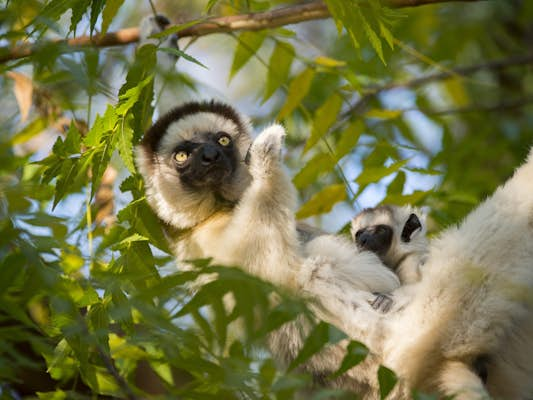From wildebeest in the Masai Mara to singing humpbacks in Tonga; from Iceland’s expansive lava fields to the ecological wonder that is Madagascar, opportunities to experience wildlife and nature in August are larger than life! Check out these four epic adventures to see Mother Nature at her finest.

Watch hordes of wildebeest in the Masai Mara, Kenya
When hundreds of thousands of trundling wildebeest hit a river, you get a huge bottleneck, and when they wade in to cross en masse, frantically splashing and dodging hungry crocodiles, it’s the highest drama imaginable. The circular migration of some 1.5 million blue wildebeest, plus attendant zebras and Thomson’s gazelles, usually reaches the Mara River flowing through Kenya’s Masai Mara National Reserve around August, which is the time to watch the spectacle of mass crossings (and feastings by crocs and lions).
- Trip planner: Most safari-goers fly into one of the airstrips in the Mara, though driving from Kenya’s capital, Nairobi, is straightforward. The lodges and camps in the west and northwest of the reserve, near the confluence of the Mara and Talek rivers, are convenient for witnessing crossings.
- Need to know: Staying in a private conservancy to the north or east of the Mara can provide more intimate wildlife watching. An alternative is to stay in the northern Serengeti in Tanzania near the Grumeti River, usually crossed in June. Crossings are never entirely predictable, though.
- Other months: Apr–Jun: wildebeest migrate northwest; Jul–Sep: move into Masai Mara; Oct: grazing in Mara; Nov–Mar: return to graze and calve in southern Serengeti.

Swim with singing humpbacks in Tonga
Tonga welcomes various visitors regular as clockwork. There are surfers, who come here to ride 10ft (3m) swells and offshore reef breaks. There are game fishers, who come to reel in blue marlin. There are sun- and beach-lovers, who seek out their own untouched piece of paradise among the 170-plus islands. But the biggest fans of this gorgeous South Pacific archipelago are the humpback whales who migrate here from Antarctica between July and September each year to calve.
This is one of the few places in the world where it’s possible to swim with these melodic behemoths – select a responsible operator and be sure not to disturb the new families. With manta rays, dolphins, sea turtles and a host of dazzling marine life joining the underwater party, Tonga is a spectacular place to snorkel and dive, while kayaking is a great way to explore the atolls and islands. There’s ancient history in the form of huge trilithons and the royal stone tombs around Mu’a, while getting to know today’s laid-back community is a treat.
- Trip plan: Tonga’s airport at Nuku’alofa is served by direct flights from Auckland, Fiji and Sydney, with lots of connections.
- Need to know: Humpback whales gather around Tonga to calve from July to September.
- Other months: Apr–Nov: drier; Dec–Mar: wettest.

Meet Madagascar’s wildlife on cool, dry days
The ‘Great Red Island’ is one of the planet’s great wildlife pageants, populated by mischievous lemurs, dancing sifakas, dazzling birds, mysterious aye-ayes, bug-eyed chameleons, cat-like fossas, giraffe-necked weevils… the animal cast list is vast and dizzyingly varied. Dry and cool August is prime time to witness this natural diversity, and to explore the spiny forests, jagged tsingy rock formations and fine beaches.
It’s also the season for whale watching, when humpbacks pass Île Sainte Marie off the east coast, and perhaps for witnessing famadihana (turning of the bones) ceremonies, honouring and remembering the dead.
- Trip plan: Madagascar is big – about the size of France – and roads are often poor, so flying makes sense, as does a visit of at least a fortnight. A typical trip starting at the capital, Antananarivo (Tana), might visit Andasibe-Mantadia National Park, Berenty Reserve, the beach at Ifaty and Isalo National Park in the south before heading back north to Tana via the rainforest at Ranomafana National Park.
- Need to know: The highlands can be cold in August, which is also peak season – book well in advance.
- Other months: Apr–Oct: generally cool, dry; Nov–Mar: wet.

Delve into Iceland’s otherwordly interior
When NASA wanted to train its astronauts for lunar conditions, it sent them to Iceland. A visit to the island’s desolate interior reveals why. It’s as barren and unforgiving as can be imagined, and experiences harsh conditions for much of the year; August is the optimum – indeed, almost the only time you can penetrate its lava fields, volcanic craters and jagged rockscapes.
A few historic routes wind through the inner highlands creating shortcuts between the north and south, with some sections only accessible to the toughest of 4WDs. The effort is rewarded with vistas of a fascinating, unique landscapes, featuring turquoise hot-water lake Víti in vast Askja caldera; the mountain known as the ‘Queen of the Desert’, Herdubreid; and the weird formations of Kverkfjöll ice caves. There’s fine hiking for the hardy, too.
- Trip plan: Fly to Reykjavík, hire the toughest 4WD vehicle you can find, and stock up with plenty of supplies – there’s not much in the interior! The least challenging route is the Kjölur, crossing rivers over bridges rather than fords – it even carries a scheduled bus during the summer.
- Need to know: Numerous huts offer accommodation across the interior, but they get booked up quickly over summer.
- Other months: Jul–Aug: most routes only open during this brief window; May–June and Sep: other parts of Iceland pleasant; Oct–Apr: colder, dark, aurora may be visible.
Looking for more inspiration for your August travels? Check out the best places to go for relaxation.
Article first published June 2017, and updated June 2019
